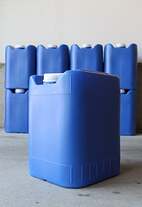A common question I am asked about preparing for any type of emergency is how often you should rotate your water storage. If you’ve tried to search around on the internet for an answer, there is a lot of conflicting information. I hope this article will not only answer your question but also help you feel more confident about preparing for an emergency.
Why Should Your Rotate Water Storage
If your water is not stored correctly, bacteria and algae can start growing inside the container and make it impossible to drink during a crisis. If you decide to use store-bought water, it needs to be rotated by the expiration date since the plastic used contains BPA.
"Although studies support the safety of BPA exposure at low levels, such as those in normal water-bottle use, both the U.S. Food and Drug Administration and the National Toxicology Program have expressed substantial concerns about the effects of BPA on the endocrine and cardiovascular systems; infants and children are at particular risk. A 2009 study from the Harvard School of Public Health revealed that participants who drank for a week from bottles containing BPA showed a two-thirds increase of BPA in their urine." - National Geographic
How Often?
When you treat water properly and have it in a dark and cool area, you could potentially get away with never having to rotate your water. As a good rule of thumb, we recommend that you check your water every 6 – 12 months. To help, we created this application to set up yearly reminders to check your water.
What You’ll Need to Check For:
- Build Up Around the Edges
- Bacteria
- Algae
- Cloudy Water
- Foul Smell
How to Preserve Your Water Storage:
- Keep your water in an opaque container (green or blue)
- Store in a cool and dark place
- Treat your water with water preserver or chlorine
How to Clean Your Water Container or Tank
Cleaning out your container is pretty simple and can be done by anyone. First, you need to wash out the tank. Pick an area that is open and not cluttered. Make sure to use mild soap and water. When cleaning the inside of the barrel, use a scratch pad to get the hard to get areas. Rinse out and repeat the process if you suspect it has been in contact with bacteria or other harmful substances. It is important to make sure that there is no soap or chemicals inside the container once you rinse it out.
How to Treat Your Water Storage
Most people recommend that you use chlorine or bleach to treat the water before storage. However, this can be pretty tricky; adding too much can be harmful, adding too little won't help much. We recommend that you use the water preserver. With just one little bottle, you can treat 50 - 55 gallons of water and extend the shelf-life from 12 months to 5 years. We still recommend that you get into the habit of checking your water supply every 6 - 12 months just to make sure your water storage is clean.
How often do you rotate your water storage?
Share your experiences, strategies and tips for your water preps and how you often you rotate and check on your stored water.
~ Brandon Garrett
Brandon Garrett is a preparedness consultant and team member of The Ready Store. He writes informative articles and information for the ReadyBlog, the Ready Store's blog and educational section pertaining to topics of the economy, resiliency, and preparedness issues.
Full disclosure: Based on our existing relationship with The Ready Store, PeakProsperity.com will receive a small commission as an affiliate for purchases made through the Ready Store. This will not impact the price you pay and the proceeds we received will be immediately invested to fund new features and functionality for this site.
This is a companion discussion topic for the original entry at https://peakprosperity.com/rotating-your-water-storage/
